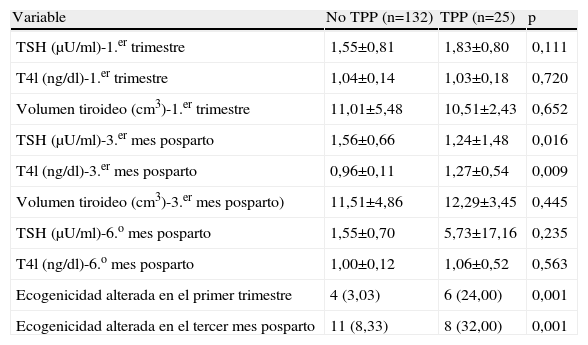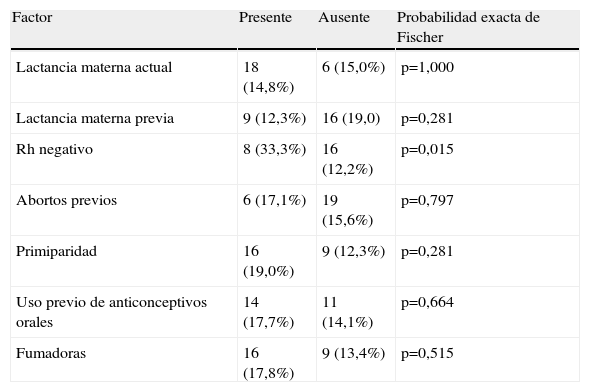Nuestro objetivo fue estudiar la presencia de tiroiditis posparto (TPP) en un grupo de mujeres embarazadas y eutiroideas.
Material y métodoEstudio observacional y prospectivo realizado, durante casi 3 años, en las embarazadas de una zona de salud de Toledo.
Se recogieron datos de talla y peso, edad, consumo de tabaco, consumo de anticonceptivos y embarazos, lactancia y abortos anteriores a la gestación actual. En el primer trimestre de ésta se determinó la hormona tiroestimulante (TSH), la tiroxina libre (T4) y los anticuerpos antiperoxidasa (TPO). Se recogió una muestra aislada de orina para determinar la yoduria. A los 3 y a los 6 meses del parto se volvieron a determinar los valores de TSH, T4 libre y TPO. Dos ecografías tiroideas se realizaron coincidiendo con la determinación analítica de los 3 meses de embarazo y de los 3 meses posparto.
ResultadosSe estudió a 157 embarazadas, de las que 25 presentaron TPP (15,9%, intervalo de confianza [IC] del 95%, 10,7–22,8). En el primer trimestre del embarazo el porcentaje de mujeres con TPO positivos fue del 44,0% en las que desarrollaron TPP, frente al 4,5% de las que no lo hicieron (p<0,001). El 20% de los casos de TPP seguían hipotiroideas al final del primer año.
Encontramos un menor índice de masa corporal (IMC) medio en embarazadas con TPP que en el resto (21,7 frente a 24,5kg/m2; p=0,001). Se encontró una mayor frecuencia de TPP en mujeres con Rh negativo (el 33,3 frente al 12,2%; PEF=0,015).
ConclusionesLa incidencia de TPP supera a la registrada en otros trabajos. El porcentaje de embarazadas que se mantenían hipotiroideas al año del parto es similar al descrito en otros trabajos. Hemos encontrado relación significativa entre la TPP y el IMC y el factor Rh (asociaciones no descritas en la literatura científica). Podría estar justificado, en nuestra zona de salud, la búsqueda activa de casos de TPP.
Our objective was to evaluate the presence of postpartum thyroiditis (PPT) in a group of pregnant euthyroid women.
Material and methodThis study was prospective and descriptive in nature and was carried out over the course of three years in an urban Health District in Toledo, Spain. Information recorded included height and weight, tobacco use, previous consumption of oral contraceptives, and numbers of pregnancies and abortions prior to the current gestation. Levels of Thyroid Stimulating Hormone (TSH), free Thyroxin (FT4) and thyroid peroxidase antibodies (TPOAb) were determined during the first trimester and 3 and 6 months postpartum. A urine sample was collected for determination of iodine levels. Thyroid ultrasonography was performed on all pregnant subjects concurrently with analytical sample collection at 3 months of pregnancy and 3 months postpartum.
ResultsThe sample contained 157 pregnant women, of whom 25 (15.9%) developed PPT. Of these, 44.0% were positive for TPO antibodies in the first trimester, compared to 4.5% of the subjects who did not develop PPT (P<.001). At the end of the first year, 5 (20%) were still afflicted with hypothyroidism. The complete study group of pregnant women displayed a median urinary iodine level of 135μg/L. A minor BMI was found in the PPT subjects when compared with the rest of the study group (21.7 vs 24.5; P=.000). A greater frequency of PPT was found in Rh-negative women (33.3 vs 12.2%; P=.015).
ConclusionsThe incidence of PPT exceeded that previously reported. We have only found a significant correlation between PPT and BMI and Rh factor. Based on the high incidence rate detected in our Health District, an active search for cases of PPT might be justified.
Artículo
Comprando el artículo el PDF del mismo podrá ser descargado
Precio 19,34 €
Comprar ahora









